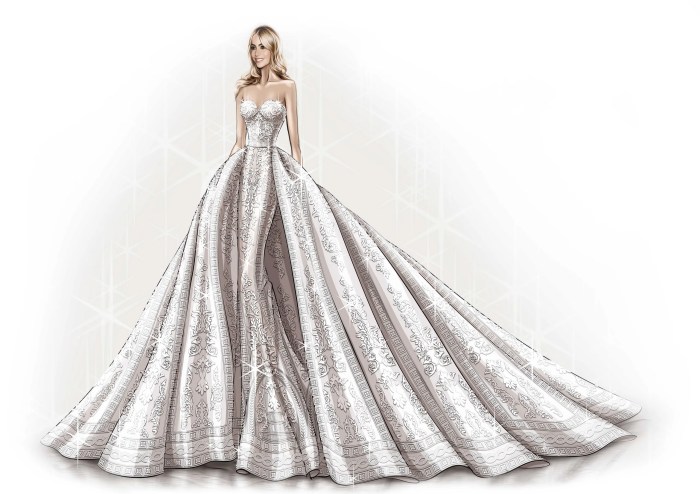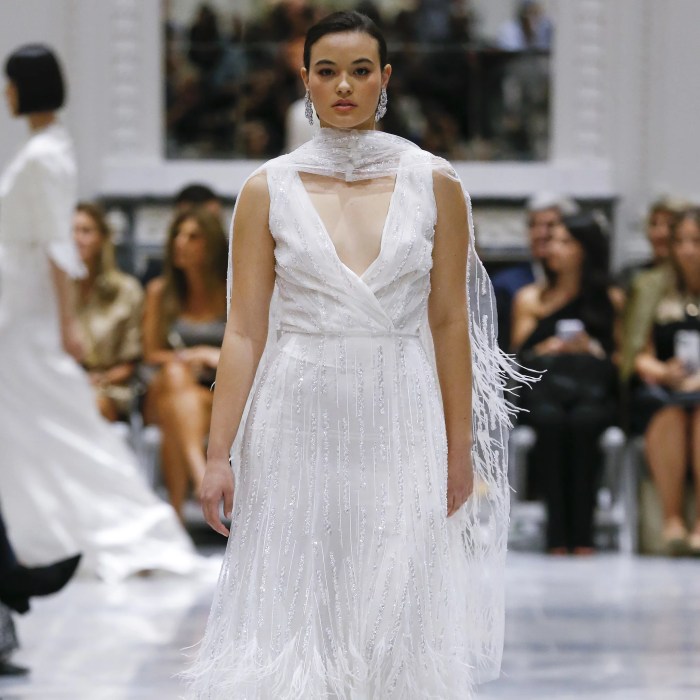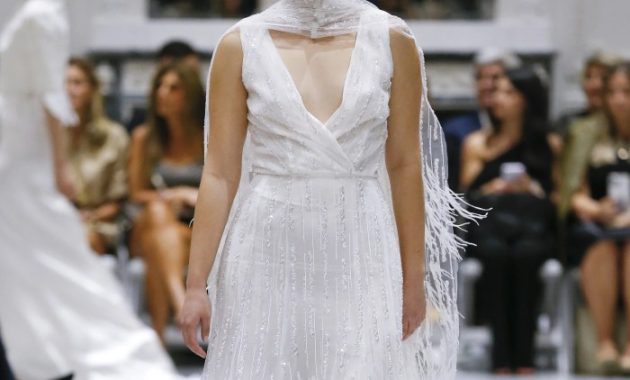Bridal Couture Wedding Dresses: A Deep Dive

Source: vogue.com
Bridal couture wedding dresses – The world of bridal couture offers a unique experience, transcending the realm of ready-to-wear gowns. It represents a journey of personalized creation, where artistry and meticulous craftsmanship converge to bring a bride’s dream dress to life. This exploration delves into the defining characteristics, design trends, and the overall experience of commissioning a couture wedding dress.
Defining Bridal Couture
Couture wedding dresses stand apart from other bridal gowns through their unparalleled level of craftsmanship, bespoke design, and the use of exquisite materials. They are not mass-produced; instead, each dress is a unique creation tailored to the individual bride’s vision and body.
Design elements frequently seen in couture gowns include intricate hand-embroidery, delicate beading, lavish lacework, and the use of luxurious fabrics like silk and hand-woven textiles. The construction techniques are highly specialized, often employing hand-stitching and advanced tailoring methods to achieve a perfect fit and flawless drape. Unlike ready-to-wear gowns, which are produced in large quantities, couture dresses are made entirely by hand, requiring countless hours of work by skilled artisans.
The difference between couture and ready-to-wear is stark. Ready-to-wear gowns offer convenience and affordability, but they lack the bespoke nature and superior craftsmanship of couture. Couture dresses provide a level of personalization and quality that is simply unmatched, reflecting the bride’s unique style and personality.
Fabrics and Materials in Bridal Couture
High-end bridal couture utilizes a range of luxurious fabrics chosen for their drape, texture, and inherent beauty. The selection process considers not only aesthetic appeal but also durability and suitability for the specific design. Sustainable sourcing is also increasingly important in the modern couture landscape.
| Fabric | Drape | Texture | Cost |
|---|---|---|---|
| Silk | Excellent, fluid | Smooth, luxurious | High |
| Lace | Moderate, depending on type | Delicate, intricate | Medium to High |
| Tulle | Good, airy | Soft, sheer | Medium |
| Organza | Stiff, structured | Crisp, sheer | Medium |
Beyond traditional fabrics, contemporary bridal couture showcases innovative materials such as hand-dyed silks, recycled fabrics, and sustainable alternatives to traditional laces. This reflects a growing awareness of environmental concerns within the industry.
Design Trends in Bridal Couture Wedding Dresses

Source: popsugar-assets.com
Current bridal couture showcases a diverse range of styles, reflecting evolving tastes and societal influences. Three prominent trends are the resurgence of classic silhouettes with modern twists, the embrace of bold colors and unconventional fabrics, and the integration of sustainable and ethically sourced materials.
- Classic with a Twist: Reimagined A-line gowns with unique necklines or sleeves, ballgowns featuring unexpected detailing.
- Bold Colors and Fabrics: Dresses in jewel tones, metallic fabrics, or incorporating unconventional textures like feathers or embroidery.
- Sustainable and Ethical Choices: Gowns made from recycled fabrics, organic materials, or featuring minimal embellishments to reduce environmental impact.
Comparing these trends to previous decades reveals a cyclical nature in bridal fashion. While classic silhouettes remain timeless, modern couture often reinterprets them with contemporary details. Previous eras saw a focus on specific shapes (e.g., the voluminous skirts of the 1950s), while current trends offer a broader spectrum of styles.
A timeline of bridal couture design trends would show a fascinating evolution, from the Victorian era’s ornate gowns to the sleek, minimalist styles of the 1920s, the full-skirted elegance of the 1950s, and the more diverse and inclusive trends of today.
The Couture Bridal Experience, Bridal couture wedding dresses
Commissioning a couture wedding dress is a deeply personal journey involving several key stages. The process begins with an initial consultation where the bride shares her vision, and the designer assesses her body type and preferences.
The design and creation process involves multiple fittings and adjustments to ensure a perfect fit and flawless execution. The designer and seamstress work collaboratively, translating the bride’s vision into a tangible creation. The designer guides the aesthetic choices, while the seamstress executes the technical aspects of dressmaking.
Initial Consultation & Design Sketches
Fabric Selection & Pattern Making
First Fitting & Adjustments
Final Fitting & Embellishment
Pricing and Accessibility of Bridal Couture
The cost of a couture wedding dress is influenced by various factors, including the designer’s reputation, the complexity of the design, the materials used, and the number of hours of labor involved. Prices can range from tens of thousands to hundreds of thousands of dollars.
While couture is undoubtedly a significant investment, brides can balance cost and quality by carefully considering design details, fabric choices, and the level of embellishment. Opting for simpler designs or using less expensive, yet high-quality, fabrics can help manage the overall cost without compromising the craftsmanship and elegance of the gown.
Illustrative Examples of Bridal Couture
Imagine a gown crafted from ivory silk crepe, featuring a sleek, column silhouette with a high neckline and a dramatic train. Delicate hand-beading adorns the bodice, creating a constellation of shimmering light. This design exudes timeless elegance.
Another example might be a dress made from intricately embroidered lace, cascading down from a fitted bodice to a full, voluminous skirt. The lace itself is a masterpiece, featuring floral motifs and delicate leaf patterns, all meticulously handcrafted. The overall aesthetic is romantic and ethereal.
A third example could showcase a modern, minimalist design in a bold color like emerald green. The gown is crafted from a luxurious silk satin, falling in a flowing, asymmetrical silhouette. Minimal embellishment allows the fabric’s rich color and drape to take center stage, creating a striking and contemporary look. The beading on this dress, concentrated along the neckline and waistline, uses tiny, faceted crystals that catch the light, creating a subtle sparkle.
Iconic couture wedding dresses include Grace Kelly’s elegant lace gown by Helen Rose, and various designs by Vera Wang, known for their timeless elegance and innovative designs. The inspiration behind many couture dresses often comes from historical periods, art movements, or the bride’s personal story, creating truly unique and unforgettable pieces.
Detailed FAQs: Bridal Couture Wedding Dresses
How long does it take to create a couture wedding dress?
The creation of a couture wedding dress typically takes several months, sometimes even longer, depending on the complexity of the design and the level of embellishment.
Can I make alterations to a couture wedding dress after it’s completed?
Yes, minor alterations are usually possible, but significant changes may be challenging and costly due to the intricate nature of the construction.
What happens if I need to change the design during the creation process?
Design changes are usually possible, but they may affect the timeline and cost of the project. Open communication with your designer is crucial.
Are there any ethical considerations when choosing couture bridal wear?
Yes, consider the sustainability of fabrics, fair labor practices of the atelier, and the overall environmental impact of the production process.

